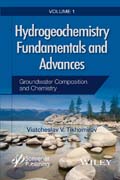
Hydrogeochemistry Fundamentals and Advances: Groundwater Composiiton and Chemistry
Tikhomirov, Viatcheslav V.
INDICE: Preface xv .Introduction 1 .1 Analytical Composition and Properties of Ground Water 19 .1.1 Moisture 21 .1.2 Mineral Components 29 .1.2.1 Testing and Preparation 30 .1.2.2 Chemical Analysis 34 .1.2.3 Processing of Analysis Results 35 .1.3 Gas Components 41 .1.3.1 Testing and Preparation 43 .1.3.2 Analysis of the Natural Gas Composition 49 .1.3.3 Conversions of Gas Analysis Results 52 .1.4 Organic Components 56 .1.4.1 Testing and Preparation 60 .1.4.2 Analysis of Organic Substance 68 .1.4.2.1 General Content of Organic Matter 68 .1.4.2.2 Content of Organic Component Groups 70 .1.4.2.3 Content of Individual Organic Components 74 .1.4.3 Conversion of Analysis Results 74 .1.5 Substances in the Dispersed State 76 .1.5.1 Inert Suspended Particles 78 .1.5.1.1 Methods of Study 79 .1.5.2 Living Organisms 80 .1.5.2.1 Pathogen Microorganisms 81 .1.5.2.2 Biochemical Microorganisms 86 .1.5.2.3 Methods of Study 86 .1.6 Properties of Ground Water 89 .1.6.1 Organoleptic and Balneological Properties 90 .1.6.2 Chemical Properties 96 .1.6.3 Physical Properties 113 .2 Hydrogeochemical Testing 125 .2.1 Assignment and Purpose of Hydrogeochemical Testing 126 .2.1.1 Regime and Scope of Testing 127 .2.1.2 Measured Parameters and Their Errors 128 .2.2 Logistics of Field Testing 131 .2.2.1 Natural Conditions and Previous Studies of the Area 132 .2.2.2 Planning the Testing Regime and Points 133 .2.2.3 Preparation of Wells and Equipment 138 .2.2.4 Preparation of Analytical Base 148 .2.2.4.1 Selection of Property and Composition Parameters 150 .2.2.4.2 Substantiation of Margin of Error Measurements 151 .2.2.4.3 Selection of Chemical Analysis Technique 164 .2.2.4.4 Selection of a Laboratory and Executants 197 .2.2.5 Field Testing Protocol 202 .2.2.6 Sample Safekeeping and Delivery to the Laboratory 212 .3 Processing of Testing Results 215 .3.1 Processing and Systematization of Observed Values 216 .3.1.1 Checking the Observed Values 216 .3.1.2 Systematizing the Observed Values 219 .3.1.3 Control of Measurement Quality 222 .3.1.3.1 Sensitivity of Testing Techniques 224 .3.1.3.2 Precision of Testing Results 225 .3.1.3.3 Testing Correctness of the Results 228 .3.1.3.4 Systematic Error of the Testing Results 229 .3.1.3.5 Testing Results Accuracy 231 .3.1.4 Measurements Results and Their Reliability 232 .3.1.4.1 Mathematical Expectation 232 .3.1.4.2 Confidence Interval 233 .3.2 Modeling of the Hydrogeochemical Condition 237 .3.2.1 Empirical statistical Modeling 238 .3.2.1.1 Anomalies and Background 238 .3.2.1.2 Water Distinction in Quality Parameters 240 .3.2.1.3 Search for the Factors 244 .3.2.2 Space time Modeling 247 .3.2.2.1 Autocorrelation Metamodels 249 .3.2.2.2 Semivariance Metamodels 254 .3.3 Classification and Visualization of Hydrogeochemical Parameters 261 .3.3.1 Chemical Classification of Ground Waters 262 .3.3.2 Graphic Imaging of the Water Composition 269 .3.3.3 Graphic Comparison of Different Composition Waters 272 .3.3.4 Hydrogeochemical Maps and Cross sections 276 .3.3.4.1 Making Hydrogeochemical Maps 278 .3.3.4.2 Generating Hydrogeochemical Cross sections 288 .Symbols 291 .References 297 .Index 301
- ISBN: 978-1-119-16039-7
- Editorial: John Wiley & Sons
- Encuadernacion: Cartoné
- Páginas: 322
- Fecha Publicación: 19/01/2016
- Nº Volúmenes: 1
- Idioma: Inglés
